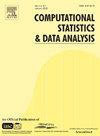增强交互树桩以建模交互
IF 1.6
3区 数学
Q3 COMPUTER SCIENCE, INTERDISCIPLINARY APPLICATIONS
引用次数: 0
摘要
在许多应用程序中,结合交互效果对于精确地建模复杂的潜在关系是必不可少的。通常,不仅需要强大的预测性能,还需要结果模型的可解释性。这种需求在流行病学等领域是显而易见的,在这些领域,揭示生物机制的相互作用对于理解复杂疾病至关重要。经典的线性模型,经常用于构建遗传风险评分,不能自主地捕获相互作用的影响,而现代机器学习方法,如梯度增强,经常产生缺乏可解释性的黑箱模型。现有的线性相互作用模型在很大程度上局限于考虑双向相互作用。为了解决这些限制,引入了一种新的统计学习方法BITS (Boosting Interaction Tree Stumps)来构建线性模型,同时自主检测和整合交互效应。BITS在交互树桩上使用梯度增强,即具有单个分裂的决策树,在BITS中,这种分裂可能发生在交互项上。在BITS中采用分支定界方法来丢弃弱预测项。针对高维数据,提出了一种贪婪和穷举相结合的混合搜索策略。正则化技术集成,以防止过度拟合和包含虚假的相互作用的影响。仿真研究和实际数据应用表明,BITS产生的可解释模型具有较强的预测性能。此外,在模拟研究中,BITS主要识别真正有影响力的术语。本文章由计算机程序翻译,如有差异,请以英文原文为准。
Boosting interaction tree stumps for modeling interactions
Incorporating interaction effects is essential for accurately modeling complex underlying relationships in many applications. Often, not only strong predictive performance is desired, but also the interpretability of the resulting model. This need is evident in areas such as epidemiology, in which uncovering the interplay of biological mechanisms is critical for understanding complex diseases. Classical linear models, frequently used for constructing genetic risk scores, fail to capture interaction effects autonomously, while modern machine learning methods such as gradient boosting often produce black-box models that lack interpretability. Existing linear interaction models are largely limited to consider two-way interactions. To address these limitations, a novel statistical learning method, BITS (Boosting Interaction Tree Stumps), is introduced to construct linear models while autonomously detecting and incorporating interaction effects. BITS uses gradient boosting on interaction tree stumps, i.e., decision trees with a single split, where in BITS this split can possibly occur on an interaction term. A branch-and-bound approach is employed in BITS to discard weakly predictive terms. For high-dimensional data, a hybrid search strategy combining greedy and exhaustive approaches is proposed. Regularization techniques are integrated to prevent overfitting and the inclusion of spurious interaction effects. Simulation studies and real data applications demonstrate that BITS produces interpretable models with strong predictive performance. Moreover, in the simulation study, BITS primarily identifies truly influential terms.
求助全文
通过发布文献求助,成功后即可免费获取论文全文。
去求助
来源期刊

Computational Statistics & Data Analysis
数学-计算机:跨学科应用
CiteScore
3.70
自引率
5.60%
发文量
167
审稿时长
60 days
期刊介绍:
Computational Statistics and Data Analysis (CSDA), an Official Publication of the network Computational and Methodological Statistics (CMStatistics) and of the International Association for Statistical Computing (IASC), is an international journal dedicated to the dissemination of methodological research and applications in the areas of computational statistics and data analysis. The journal consists of four refereed sections which are divided into the following subject areas:
I) Computational Statistics - Manuscripts dealing with: 1) the explicit impact of computers on statistical methodology (e.g., Bayesian computing, bioinformatics,computer graphics, computer intensive inferential methods, data exploration, data mining, expert systems, heuristics, knowledge based systems, machine learning, neural networks, numerical and optimization methods, parallel computing, statistical databases, statistical systems), and 2) the development, evaluation and validation of statistical software and algorithms. Software and algorithms can be submitted with manuscripts and will be stored together with the online article.
II) Statistical Methodology for Data Analysis - Manuscripts dealing with novel and original data analytical strategies and methodologies applied in biostatistics (design and analytic methods for clinical trials, epidemiological studies, statistical genetics, or genetic/environmental interactions), chemometrics, classification, data exploration, density estimation, design of experiments, environmetrics, education, image analysis, marketing, model free data exploration, pattern recognition, psychometrics, statistical physics, image processing, robust procedures.
[...]
III) Special Applications - [...]
IV) Annals of Statistical Data Science [...]
 求助内容:
求助内容: 应助结果提醒方式:
应助结果提醒方式:


